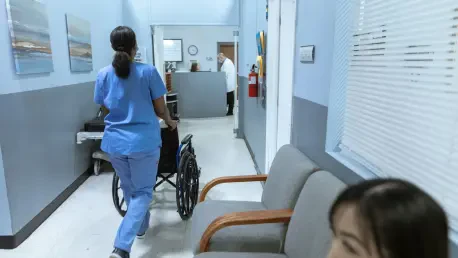The specialty medical chairs market is on a significant upward trajectory, projected to reach a value of USD 8.47 billion by 2032, doubling from its current market size of USD 4.6 billion. This impressive growth trajectory reflects a compound annual growth rate (CAGR) of 7.04% over the next seven years, exemplifying the increasing reliance on these essential healthcare tools. Aging populations worldwide and a surge of chronic medical conditions like obesity, diabetes, and cardiovascular diseases are primary drivers for this expansion. As the global landscape of healthcare needs continuously evolves, specialty medical chairs are emerging as crucial for patient mobility, safety, and comfort, providing versatile solutions that facilitate examination, rehabilitation, and bariatric care in diverse medical settings.
Technological Advancements Driving Growth
Impact of Innovative Designs and Features
The market for specialty medical chairs is witnessing a transformative phase spurred by technological innovations coupled with the growing emphasis on patient-centric healthcare solutions. Advanced ergonomic designs and enhanced patient support systems are revolutionizing how these chairs contribute to patient care, making them indispensable in modern healthcare practices. Moreover, the trend toward more outpatient care, minimally invasive surgeries, and increased home healthcare adoption is further perpetuating this growth. These technological advancements ensure not only enhanced functionality but also improved comfort and safety for patients, thereby attracting greater adoption among healthcare providers. As manufacturers continue to focus on integrating cutting-edge technology, specialty medical chairs are becoming vital components in providing comprehensive care to patients, aligning with a broader trend toward more efficient and effective healthcare delivery mechanisms.
Influence of Healthcare Infrastructure Developments
In parallel with technological advancements, improved healthcare infrastructure is significantly influencing the expansion of the specialty medical chairs market. As global investments in healthcare infrastructure continue to rise, there is a robust demand for durable and adaptable medical equipment that can support the growing complexity of patient needs. The infrastructure improvements entail enhanced accessibility and integration of specialty equipment across various healthcare facilities, underpinning the viability and necessity of such medical chairs. Governments and private entities alike are recognizing the importance of these investments in improving healthcare outcomes, thereby propelling the demand for specialty medical chairs. The emphasis on enhancing healthcare settings is not only elevating the standard of care provided but also ensuring that facilities are well-equipped to handle increasing patient volumes and complexities, thus fueling the industry’s growth.
Regional Growth Insights
United States Market Dynamics
Within the United States, the specialty medical chairs market is poised to experience substantial growth, with forecasts indicating an escalation from USD 1.64 billion in 2023 to USD 2.99 billion by 2032, maintaining a CAGR of 7.3%. This growth is significantly driven by national healthcare policies and initiatives such as Medicare and Medicaid, which encourage the adoption of innovative seating solutions through reimbursement incentives for durable medical equipment. Such financial incentives are instrumental in catalyzing the widespread integration of specialty medical chairs in healthcare facilities nationwide. Additionally, as healthcare spending continues to rise at an annual rate of 5.1%, there are abundant opportunities for market expansion, positioning the United States as a pivotal region capturing a significant share of the global market.
Contribution of Key Industry Players
The role of major industry players cannot be understated in shaping the specialty medical chairs market. Leading companies such as Danaher Corporation, A-dec Inc., and Midmark Corporation are setting benchmarks through their continuous innovation and ability to meet evolving healthcare demands. These companies are not only investing in product development but also collaborating with healthcare providers to tailor solutions that enhance patient care and service efficiency. By staying ahead in design innovation and understanding patient and provider needs, these organizations are strengthening their positioning in the market and driving competition. The collaboration between industry leaders and healthcare professionals is fostering an ecosystem where patient-centric solutions thrive, ensuring the specialty medical chairs market remains robust and responsive to future demands.
Future Considerations for the Specialty Medical Chairs Market
Sustaining Growth Through Strategic Initiatives
As the specialty medical chairs market continues to gain momentum, sustaining growth will require strategic initiatives addressing emerging challenges and opportunities. Emphasizing research and development will be crucial to maintaining a competitive edge, especially in customizing chairs according to specific healthcare needs and patient preferences. Manufacturers must also focus on strategic partnerships and collaborations across the healthcare sector to deepen their market presence and enhance product innovation. Moreover, addressing environmental and sustainability concerns by adopting eco-friendly manufacturing processes could emerge as another distinguishing factor in the marketplace. By integrating these elements, the industry can create resilient foundations for ongoing expansion, ensuring the market’s vibrancy in the years to come.
Preparing for Emerging Healthcare Needs
In preparing for future healthcare challenges, the specialty medical chairs market must remain agile and adaptable to changing dynamics and patient needs. The anticipated rise in chronic health conditions, coupled with increasing demands for personalized healthcare solutions, calls for continuous evolution in product offerings. Flexibility and scalability in design will become increasingly critical, allowing chairs to seamlessly transition across different medical environments and cater to diverse patient populations. As healthcare systems globally strive to provide more inclusive and efficient care, the role of specialty medical chairs will grow even more significant, providing pivotal support in enhancing patient experiences and outcomes. To navigate these future landscapes, industry stakeholders must align their strategies with the broader goals of advancing healthcare accessibility and quality, ensuring readiness for emerging healthcare realities.









